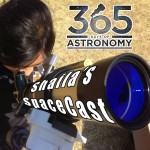Podcaster: Shaila’s SpaceCast
 Title: Tracking Time With Our Sky!
Title: Tracking Time With Our Sky!
Organization: UNSW School of Physics, CSIRO Astronomy and Space Science
Links: https://www.physics.unsw.edu.au ; http://www.csiro.au/Organisation-Structure/Divisions/Astronomy-and-Space-Science.aspx
https://www.physics.unsw.edu.au/staff/shaila-akhter
Description: This podcast gives a brief description of various ancient and modern calendars and their relationship with Astronomy.
Bio: Shaila Akhter is an Astrophysics PhD candidate, outreach co-ordinator and educator from Asutralia.
Today’s sponsor: This episode of “365 Days of Astronomy” is sponsored by — no one. We still need sponsors for many days in 2015, so please consider sponsoring a day or two. Just click on the “Donate” button on the lower left side of this webpage, or contact us at signup@365daysofastronomy.org.
Transcript:
Hi, this is Shaila Akhter from UNSW Australia and CASS. I welcome you all to my 365 days of Astronomy Podcasts! Today, I will let you explore our various calendars and their relationship with Astronomy. The oldest science practiced by mankind is ‘Astronomy’, the science about the celestial objects. The night sky has been used by our ancestors from prehistoric ages; sometimes as a compass to guide them in the ocean or in the desert, sometimes to count dates, sometimes to use religiously or mythologically, or, to celebrate festivals. The earliest Lunar calendar made by our ancestors we know today is about 35000 years old. It was identified on animal bones, and cave walls of Alb-Danube region of present day Germany. This ancient calendar, named Aurignacian Lunar Calendar, is nothing but a set of crescents and lines. The line thickness was carefully controlled by the calendar makers so that the lunar phases would be easily perceivable. They used to produce those calendars on portable stones or animal bones so that they can carry while going for hunting. This ingenious calendar not only reveals our ancestor’s abilities to read the animal activities over time, but it shows their arithmetical abilities to count days! So cool!
Today, I am going to discuss about the origins of early lunar and solar calendars, modern Gregorian calendar, and about the advantages and flaws of the modern calendar.
I will also discuss about the flaws of the modern calendar.
Easter is coming soon… Also, 14th of April is the Bangla New Year and Tamil New Year, 13th of April is the Thai New Year. Just a week back, we have passed our Winter or Summer solstice, depending on the zone of the Earth! So… it was a good time to talk about calendars today, isn’t it?
I wish you all a very happy Easter and Very Happy Bangla New Year, in advance! Also, wish you a late Winter solstice if you are from the Northern Hemisphere and late Summer Solstice for the people in the Southern Hemisphere of our lovely planet Earth!
I look forward to tell you more Astro stories in my upcoming episodes…
Take care and goodbye!!
If you have any questions or feedback, please leave a comment below! Hope you will enjoy it!
End of podcast:
365 Days of Astronomy
=====================
The 365 Days of Astronomy Podcast is produced by NUCLIO. Audio post-production by Richard Drumm. Bandwidth donated by libsyn.com and wizzard media. You may reproduce and distribute this audio for non-commercial purposes. Please consider supporting the podcast with a few dollars (or Euros!). Visit us on the web at 365DaysOfAstronomy.org or email us at info@365DaysOfAstronomy.org. This year we celebrate cosmic light as light is our info messenger in the universe. Join us and share your story to celebrate the International Year of Light. Until tomorrow! Goodbye!

